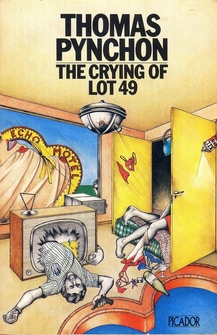
By Christopher Curtin
Thomas Pynchon's "The Crying of Lot 49," released in 1966, boasts an absolutely staggering page count of 192. Being a quintessential postmodernist book to the point of parody, it's riddled with certain hallmarks of the genre: offbeat humor, a strange and unclear amount of self-awareness, a play within a play, ridiculous character names and acronyms (both trademarks of Pynchon's; character 'Mucho' Maas, whose name sounds similar to the Spanish words for 'much more', or a poster advertising AC/DC: The Alameda County Death Cult, a joke which, strangely, predates the hard rock band of the same name by about 7 years, leaving one to wonder exactly what the poster was actually supposed to mean), supposedly hyper-intelligent dolphins, and so on.
Thomas Pynchon's "The Crying of Lot 49," released in 1966, boasts an absolutely staggering page count of 192. Being a quintessential postmodernist book to the point of parody, it's riddled with certain hallmarks of the genre: offbeat humor, a strange and unclear amount of self-awareness, a play within a play, ridiculous character names and acronyms (both trademarks of Pynchon's; character 'Mucho' Maas, whose name sounds similar to the Spanish words for 'much more', or a poster advertising AC/DC: The Alameda County Death Cult, a joke which, strangely, predates the hard rock band of the same name by about 7 years, leaving one to wonder exactly what the poster was actually supposed to mean), supposedly hyper-intelligent dolphins, and so on.
Crying follows Oedipa Maas as she entangles herself in what may be a worldwide conspiracy involving a secret postal service after she is named the executrix of her eccentric ex-boyfriend's estate. Throughout the story, Oedipa journeys through the city of San Narciso (get it?) and interacts with: Doctor Hilarius, her psychiatrist and former Nazi doctor at Buchenwald who essential prescribes LSD and LSD only; The Paranoids, a band of boneheaded American teenagers who sing with British accents at the behest of their manager; a man who seems to think he's created a perpetual motion machine (he hasn't); stamp appraiser Genghis Cohen (no relation); barfly and later lothario Mike Fallopian (also no relation); and several other incredibly, incredibly strange people.
It's worth mentioning right off the bat that this is one of the only books I've ever read that I needed to put down because it's difficult to read in the midst of a fit of laughter, and to put the last of all the cards on the table, I'm going to seem incredibly biased as though I love this book, because I do, very much so, and as such I'll get my criticisms out of the way.
First off, it's a book with some very strange things that you're just going to have to roll with, as it will not wait for you to make sense of the inanity of one sentence before it goes full-throttle on the ridiculous the next sentence, which, while you can probably spin it as a strength, can make it kind of difficult, in the way that a small child can be 'difficult'. The reason I do think this is a criticism, though, is that Crying is a book about a conspiracy theory that moves very quickly from sentence to sentence. It isn't that huge an issue, but in a book where there's a lot to think about and/or follow, it's foreseeable that this could be an issue.
Despite what you could possibly interpret as a fatal flaw, Crying is nonetheless a hallmark in its genre. It's funny, strange, absurd and by far one of the best novels in proportion to its length you can hope to find. Thomas Pynchon's The Crying of Lot 49 is an absolutely essential read and there is little more that can be said.